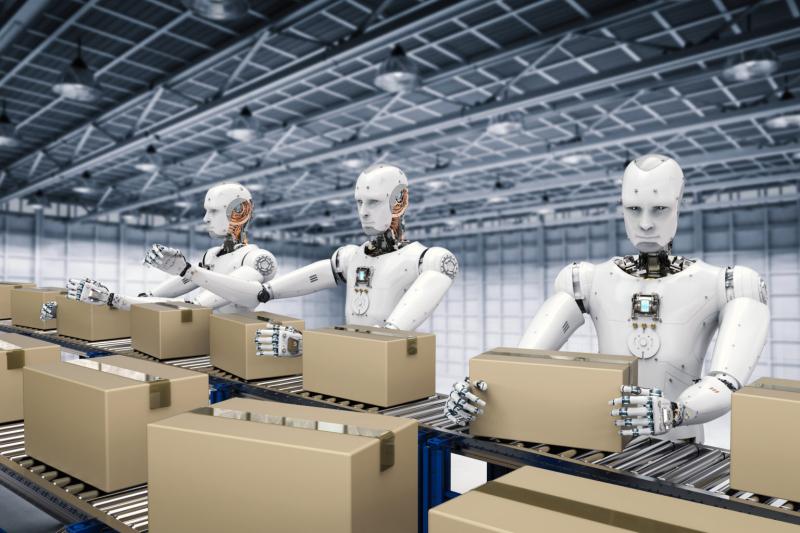- TECHSWU
- Posts
- TECHSWU #94
TECHSWU #94
Welcome to TECHSWU, your go-to destination for all things tech that matter in your daily life!


/cdn.vox-cdn.com/uploads/chorus_asset/file/23951262/VRG_Illo_N_Barclay_1_apple.jpg)
#
Apple is reportedly working on a new tabletop robot that features an iPad-style display attached to a robotic arm. According to Bloomberg, Apple has a large team working on the project, which is said to be able to tilt and spin its screen 360 degrees.
The device would have various functions, such as controlling smart home devices, attending video conferences, and monitoring home security. Apple is rumored to be aiming for a launch in 2026 or 2027, and the device could cost around $1,000.
The robot would be capable of responding to commands using Siri or Apple Intelligence features. This move into home robotics follows the cancellation of Apple's car project and the recent launch of the Vision Pro.

The consumer electronics market is experiencing significant growth thanks to new tech trends. Companies like NVIDIA and Apple are leading the charge by embracing technological advancements to stay ahead in the market.
One particular area of growth is the Mixed Reality (MR) sector, with companies like Industrial Fulian seeing impressive stock price increases. AI-powered devices are also a hot trend, with Google integrating AI into Android systems and Apple rumored to be working on AI-powered AR glasses.
Investors looking to capitalize on the growth of the consumer electronics and semiconductor industries can consider tech-focused ETFs as a strategic investment choice. The rapid deployment and adoption of 5G technology is shaping the market, enhancing connectivity and revolutionizing how devices interact and communicate.
The demand for smart home devices is also on the rise, with companies like Amazon and Google catering to the growing demand for interconnected home solutions. However, there are challenges to consider, such as cybersecurity and data privacy issues, as well as the environmental impact of electronic waste.
Staying informed about new tech trends and market dynamics is crucial for consumers, investors, and industry stakeholders to make informed decisions.


Robotic surgery is a game-changer in modern medicine, offering precision, flexibility, and control that surpass traditional surgical techniques. It involves a highly sophisticated system that translates a surgeon's hand movements into smaller, precise movements of instruments inside the patient's body.
The surgeon operates the robotic arms using hand and foot controls while viewing a magnified 3D image of the surgical site. Robotic surgery is used in a wide range of surgeries, from hernia repair to colorectal surgery to heart surgery.
It allows for smaller incisions, less post-operative pain, reduced blood loss, and faster recovery times, leading to improved patient outcomes. In hernia repair, robotic surgery offers additional options for complex repairs and faster recovery times.
In colorectal surgery, it reduces the risk of damage to surrounding tissues and organs. In heart surgery, it allows for precision and smaller incisions, resulting in less blood loss and quicker recovery.
In thoracic surgery, it enables precise dissections and suturing through small incisions, improving outcomes and quality of life. In hepato-pancreato-biliary surgery, it enhances the surgeon's ability to navigate complex anatomy and achieve better surgical outcomes.
Overall, robotic surgery has revolutionized the medical field and is increasingly used for its numerous advantages over traditional surgery.

Advancements in artificial intelligence (AI) are paving the way for humanoid robots to enter the market in a big way, bringing them closer to what is being called their "iPhone moment." Daniel Zhou Hao, an AI and robotics lecturer at the University of Leicester, explains that large language models (LLMs) are crucial for achieving embodied intelligence in robots.
These LLMs allow robots to process and use large amounts of data, enabling them to interact with their environment autonomously. For example, Google's PaLM-E multimodal language model can help robots make sense of their surroundings.
This new generation of robots could have various applications, not just in space exploration and factory assembly processes, but also in our homes, performing tasks like cleaning, cooking, and assisting the elderly. However, there are still hurdles to overcome, including cost, reliability, public perception, and ethical considerations.

The Robot as a Service (RaaS) market is experiencing significant growth due to the increasing adoption of automation in various industries. RaaS models offer cost-effective solutions by providing access to advanced robotic technologies without high upfront costs.
Additionally, RaaS offers flexibility and scalability, allowing businesses to adjust their robotic capabilities based on demand and project requirements. Continuous advancements in robotics technology, such as improvements in artificial intelligence, machine learning, and sensor technology, are enhancing the capabilities and performance of robots used in RaaS models.
The report provides a detailed segmentation and classification of the market by type and end-use industry. Major players in the market include ABB Ltd.
, Amazon Robotics, and Zebra Technologies Corporation. The report also presents insights on the growth rate, market size, major market vendors, market trends, and opportunities in the RaaS market.

.png)
Dubai-based startup BrainBridge has unveiled its concept for a robotic head transplant system. The company claims that the procedure, which would use robotics, AI, and molecular-level imaging, could offer patients suffering from terminal illnesses a new chance at life by transplanting their heads onto healthy donor bodies.
The robots would be responsible for carrying out the procedure and would utilize AI and precise imaging to ensure the precise reconnection of vital nerves. In addition to the head transplant system, BrainBridge is also working on a smart headband that would allow patients to communicate during recovery by controlling smart devices with their thoughts.
The company is in the process of recruiting engineers to assist with the development of the technology.

Turkey's Capital Markets Board (CMB) has received applications for licensing from 47 virtual asset service providers (VASPs) under the country's new capital market law. Turkey has seen significant growth in its digital asset market in recent years, driven in part by the poor performance of the local lira.
Stablecoins and digital currencies have emerged as popular alternatives for Turkish investors. To protect these investors, President Recep Tayyip Erdoğan signed a new capital markets bill into law last month, establishing a licensing regime for VASPs.
The CMB revealed the list of 47 VASPs awaiting licenses, which includes local subsidiaries of Bitfinex, Binance, and OKX. The new licensing framework aims to comply with global standards and streamline taxation.
The Turkish government plans to impose a 0.03% tax on digital asset transactions, which could add $110 million to the exchequer.

The Lagos State Government in Nigeria plans to tokenize real estate on the blockchain, making them easily transferable as non-fungible tokens (NFTs). The initiative is part of a larger plan to increase the state's internally generated revenue.
The tokenization process is expected to take 16 months and will be carried out by the Ministry of Science & Technology in collaboration with other agencies and partners, using a budget of ₦500 million. Tokenization involves converting physical or virtual assets into digital tokens that can be traded or transferred.
In the case of real estate, it allows for the division of ownership into smaller, easily tradable parts. This initiative could make real estate investments more accessible and liquid, allowing multiple investors to pool funds to purchase assets.
However, challenges such as regulation and the lack of accurate real estate data must be addressed to make tokenization successful.

Oxipital AI, previously known as Soft Robotics, has divested its gripper business assets to focus exclusively on its 3D vision and artificial intelligence (AI) solutions. The company's end-to-end visual AI solutions are designed to reduce the need for onsite machine learning and bring a level of "intuition" that is typically associated with humans.
The technology uses synthetic data generation and synthetic training of neural networks, meaning customers do not need to take multiple images of their products or use conventional machine learning and AI techniques. Oxipital AI's CEO, Mark Chiappetta, explains that the deep understanding of a customer's product is already embedded in the system when it is shipped, and customers can use no-code graphical tools to set up rules about what is considered a good or bad product.
This approach sets Oxipital AI apart from its competitors in the field.
Humanoid robots are revolutionizing China's innovation-led drive towards growth. These human-like machines are being developed with state-of-the art technologies such as artificial intelligence and robotics, and are beginning to venture out of labs and expos into workshops.
Industrial giant UBTECH recently introduced its products in a smart automobile plant, where the humanoid robots assist workers in carrying auto parts. The market size of humanoid robots in China is predicted to reach 2.
76 billion yuan in 2024, and 75 billion yuan by 2029, accounting for about a third of the global total. China's solid high-end manufacturing sector, a growing AI market, and a supportive government policy framework have created a nurturing ecosystem for humanoid robotics.
Despite the fast growth, experts warn against an irrational rush into the industry, emphasizing that real technological breakthroughs will require time, money, and teamwork.


In a dazzling event held in Doha, Qatar, a leading mobile phone company unveiled its cutting-edge technology, captivating the audience and key industry figures. The company's partnership with a renowned distributor aims to bring state-of-the-art mobile devices to the Qatari market, blending innovation with affordability.
The event showcased not only the latest smartphone models but also highlighted the brand's commitment to advanced features and captivating designs. By pushing boundaries in emerging markets, the company solidified its position as a trailblazer in the mobile technology industry.
Additional insights have emerged following the event, including enhanced AI capabilities in the new mobile devices, competitive pricing strategies, and the impact on user experience and accessibility. However, challenges such as privacy concerns and environmental impact also accompany these advancements, emphasizing the need for robust privacy measures and sustainable practices.
This unveiling marks a turning point in the mobile industry, promising enhanced user experiences while addressing challenges and ensuring a positive impact on society and the environment.

Artificial intelligence has entered the world of fashion and beauty, including the field of manicures. The goal is to enhance the consumer experience by offering immediate and time-saving services.
One example of this is the AI-powered robotic manicure, which is being launched in select XpresSpa airport locations in the United States. The robotic manicure involves the use of artificial intelligence and 3D imaging to scan each visitor's nails before a robot precisely paints them in just 10 minutes, without any human intervention.
Another example is the O'2NAILS nail printer, which uses AI and 3D technology to create custom designs on nails in minutes. These devices offer pros such as personalization, speed, efficiency, and accessibility, but also have cons such as cost, lack of human touch, and potential impact on traditional nail artists' jobs.
Overall, the introduction of AI into the manicure industry is revolutionizing the way we think about getting our nails done.

Tech Mahindra has partnered with LivePerson to enhance customer engagement in the financial services and healthcare and life sciences sectors. The collaboration will combine LivePerson's conversational platform and artificial intelligence (AI) technology with Tech Mahindra Business Process Services' domain expertise.
By leveraging AI-driven solutions, the partnership aims to offer personalised customer experiences, automate administrative tasks, and ensure data security and compliance. The companies are also committed to speeding up time-to-market by combining AI technology with human expertise.
Tech Mahindra's BPS will utilize LivePerson's Conversational Cloud platform to develop solutions that reduce patient wait times, improve accessibility, streamline patient onboarding, and ensure data security in the healthcare sector. In the financial services industry, the partnership seeks to reduce operational costs, improve security, and enhance customer satisfaction through AI agents, authenticated messaging, and self-service capabilities.

Hong Kong plans to enhance its regulation of digital assets, with a particular focus on stablecoins, within the next 18 months, according to a Legislative Council member. The move is part of Hong Kong's effort to become a global hub for financial technology.
David Chiu, a member of the Legislative Council of the Hong Kong Special Administrative Region, highlighted the importance of establishing a sound exchange system and introducing legislation related to stablecoins. Stablecoins, such as Tether and Circle's USDC, have gained widespread utility and are seen as posing a potential systemic risk to traditional finance.
Hong Kong has been working on stablecoin regulations for the past few years, with the Hong Kong Monetary Authority issuing a discussion paper in 2022 and final recommendations in 2023. The government is conducting consultations and aims to release final guidelines later this year.
The Hong Kong Monetary Authority has also launched a sandbox arrangement to facilitate discussion between the regulator and the industry.
